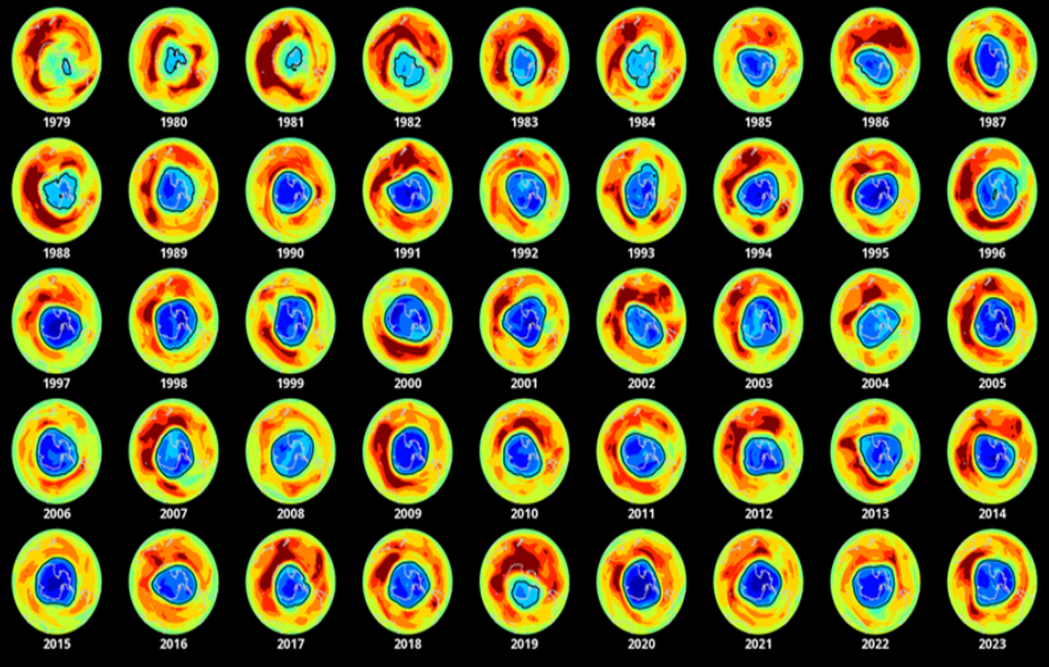- Courses
- GS Full Course 1 Year
- GS Full Course 2 Year
- GS Full Course 3 Year
- GS Full Course Till Selection
- MEP (Mains Enrichment Programme) Data, Facts
- Essay Target – 150+ Marks
- Online Program
- GS Recorded Course
- NCERT- First Ladder
- Polity
- Geography
- Economy
- Ancient, Medieval and Art & Culture AMAC
- Modern India, Post Independence & World History
- Environment
- Governance
- Science & Technology
- International Relations and Internal Security
- Disaster Management
- Ethics
- Current Affairs
- Indian Society and Social Issue
- CSAT
- 5 LAYERED ARJUNA Mentorship
- Public Administration Optional
- ABOUT US
- OUR TOPPERS
- TEST SERIES
- FREE STUDY MATERIAL
- VIDEOS
- CONTACT US
World Ozone Day 2024 Theme: Montreal Protocol-Advancing Climate Actions
World Ozone Day 2024 Theme: Montreal Protocol-Advancing Climate Actions
- September 16th is designated as the International Day for the Preservation of the Ozone Layer by the United Nations.
- This day highlights the importance of protecting the ozone layer, which shields the Earth from harmful ultraviolet radiation.
- India has been celebrating this day since 1995.
- The theme for 2024 is "Montreal Protocol: Advancing Climate Actions," emphasizing the protocol's dual role in safeguarding the ozone layer and mitigating climate change.
About ‘Ozone’
- Ozone (O3) is a reactive gas, consisting of three oxygen atoms.
- It exists in two forms:
- Stratospheric ozone, found in the Earth's upper atmosphere (15-30 km), is naturally produced by the interaction of solar ultraviolet light with molecular oxygen. It acts as a protective shield against harmful UV radiation.
- Tropospheric or ground-level ozone is mainly created by photochemical reactions involving volatile organic compounds (VOC) and nitrogen oxides. It is a pollutant and can be harmful to human health and the environment.
- The term "ozone hole" refers to areas where the ozone layer has been significantly depleted, allowing more harmful UV radiation to reach the Earth's surface.

Some important facts about Ozone |
|
How is ozone layer depleted?
- The ozone layer is depleted in both hemispheres of the Earth, specifically Antarctica in the Southern Hemisphere and the Arctic in the Northern Hemisphere. However, the phenomenon is more recognised in Antarctica than in the Arctic.
- The mechanism of the ozone hole is intimately related to the temperature of the stratosphere. If the temperature goes below -78 degrees Celsius, stratospheric clouds form, worsening the status of the ozone hole.
- The extent of the ozone hole above Antarctica varies each year, beginning in August and closing in November or December.
- Some consumer goods and industrial activities release “halogen source gases” into the atmosphere. The ozone layer is weakened by these gases bringing chlorine and bromine into the stratosphere.
- For instance, practically all air conditioning and refrigeration systems contain chlorofluorocarbons, eventually making their way to the stratosphere where they break down to produce chlorine atoms that deplete the ozone layer.
- Halons, used in fire extinguishers contain ozone-depleting bromine atoms. Here comes the important role of the Montreal Protocol — governing the global production and consumption of all primary halogen source gases resulting from human activity.
Why is ozone depletion harmful?
Exposure to UltraViolet B (UVB) rays has various effects on:
A. Human Health: The depletion of the ozone layer has resulted in low amounts of ozone, which means reduced protection from the sun’s rays and increased exposure to UVB radiation at the Earth’s surface. Laboratory and epidemiological research show that UVB induces non-melanoma skin cancer and plays an important role in malignant melanoma formation. UVB has also been related to the development of cataracts, which are cloudy lenses in the eyes.
B. Flora Life: UVB radiation affects the plants — both physiologicaly and in their development processes. The growth of trees is affected directly and indirectly by the UVB radiation. For instance, nutrient distribution and developmental phase are indirectly affected.
C. Marine Life: Phytoplankton production is limited to the euphotic zone, the upper layer of the water column that receives enough sunshine to support net productivity. Solar UVB radiation has been proven to influence phytoplankton orientation and motility, resulting in lower survival rates. Small increases in UVB radiation can cause population declines in small marine organisms, having repercussions for the entire marine food chain.
D. Terrestrial Life: Increased UVB radiation can have an impact on terrestrial biogeochemical cycles, affecting both sources and sinks of greenhouse gases and chemically significant trace gases such as carbon dioxide and carbon monoxide.
What the Montreal Protocol is exactly?
- Adopted on September 16, 1987, the Montreal Protocol is the landmark multilateral environmental agreement that regulates the production and consumption of man-made chemicals referred to as ozone-depleting substances (ODS). The stratospheric ozone layer is damaged by these ODS.
- According to the UNEP website, the Montreal Protocol phases down the consumption and production of the different ODS step-wise, with different timetables for developed and developing countries. Under the treaty, all parties have specific responsibilities related to the phase-out of the various groups of ODS, control of ODS trade, annual reporting of data, national licensing systems to check the imports and exports of ODS and other matters.
- There are different responsibilities for developing and developed countries, but the countries have binding, time-targeted, and measurable commitments.
Implementation of the Montreal Protocol
- Hydrochlorofluorocarbons (HCFCs) are used for different purposes such as refrigeration, air conditioning, and foam applications.
- However, they were phased out under the Montreal Protocol due to their ozone layer depleting effects. These are considered ODS and powerful greenhouse gases.
- The most commonly found HCFC has a global warming potential (GWP) around 2,000 times that of CO2. The parties agreed in 2007 to phase out HCFCs to maintain the climate of the Earth.
Universal ratification of the Montreal Protocol
- On September 16, 2009, the Vienna Convention and the Montreal Protocol became the first treaties in United Nations history to be universally ratified.
- The Vienna Convention was the first treaty of any kind to be signed by all participating countries, taking effect in 1988 and being universally ratified in 2009.
The Kigali Amendment
- Hydrofluorocarbons (HFCs) are a distinct family of compounds that were developed to help with the timely phase-out of CFCs and HCFCs as non-ozone-depleting alternatives.
- Nowadays, HFCs are often found in refrigerators, air conditioners, foams, aerosols, and other products. These substances are safe for the stratosphere’s ozone layer, however, they have high global warming potentials (GWPs) of around 12000-14,000.
- The Parties to the Montreal Protocol voted to phase down HFCs at their 28th Meeting of the Parties, held on October 15, 2016, in Kigali, Rwanda.
- HFCs were added to the list of compounds under international control, and a plan to gradually reduce them by 80-85% by the late 2040s was approved.
Wondering how much has the situation improved now?
- Since 2000, the condition of the ozone hole has been improving due to the effective implementation of the Montreal Protocol.

- According to a recent scientific assessment, the effective implementation of the Montreal Protocol will help the ozone layer to restore to 1980 levels over Antarctica by 2066, the Arctic by 2045, and the rest of the world by 2040.
- Eliminating ozone-depleting chemicals also has significant climate change benefits. These compounds are also potent greenhouse gases, with some being hundreds or thousands of times more harmful than carbon dioxide, the most abundant greenhouse gas and primary cause of global warming.
- The research said that global compliance with the Montreal Protocol will assure the prevention of 0.5 to 1 degree Celsius of warming by 2050.
Must Check: Best IAS Coaching In Delhi
UPSC Prelims Result 2024 Out: Expected Cut Off & Other Details, UPSC Prelims 2024 Answer with Explanation, Daily Prelims Quiz, Daily Current Affairs, MONTHLY CURRENT AFFAIRS TOTAL (CAT) MAGAZINE, Best IAS Coaching Institute in Karol Bagh, Best IAS Coaching Institute in Delhi, Daily Mains Question Answer Practice, ENSURE IAS UPSC Toppers, UPSC Toppers Marksheet, Previous Year Interview Questions, UPSC Syllabus




